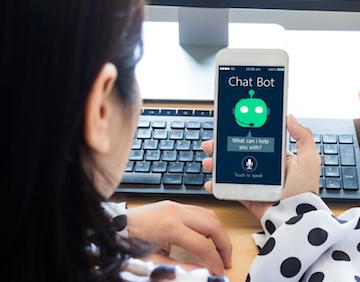Why Machine Learning Can Improve Customer Service
Machine learning-powered chatbots offer companies the possibility of saving money while improving customer service.

AI is changing our everyday interactions. What once required a human rep can now be handled by a virtual assistant whose programming allows customer problems to be solved more quickly.
A recent Venturebeat article declared, "AI chatbots are the next big shift in customer service." Those of us of a certain generation expect to wait on a line or on the phone for a person to take care of our customer service issues. But the generation that favors texts to calls has come to have different expectations.
A survey of 1,500 millennials in North America found that 65% preferred not to have to engage a human in person or on the phone. That's actually good news for businesses that embrace the technology because they can improve customer satisfaction at lower costs by implementing chatbots and virtual assistants powered by AI.
One of the companies that enables businesses to harness the power of AI in that way is Rul.ai. Yi Zhang, co-founder and CTO of Rul.ai also teaches data mining. She spoke with All Analytics about data mining works for virtual agents to allow for personalized responses.
Just like Amazon and Netflix learn more about customers through their use of the sites and then can offer more on targeted recommendations, interactions with virtual assistants enable companies to "know more about you and provide more" help in finding what you seek, Zhang explains. "We use AI technologies in natural language processing, deep learning to build the next generation of virtual assistants."
[Learn more about AI and Machine Learning. Sign up now for the next edition of the A2 Academy.]
Should organizations reveal that customer queries are being handled by chatbots? Zhang said that it is better for businesses to do so. She concedes that there are some observable differences between "human to human conversations and human to machine conversations." She also explained "Studies show that it would cut back on social chat like 'how are you?'" While this is considered part of polite human interaction, it becomes irrelevant in the context of explaining the problem to a virtual assistant.
An efficient solution to the problem is what virtual assistant are all about. That's the main appeal for the customer, that they can get right to it "rather than waiting 30 minutes" for a human rep to come on. In cases in which the virtual assistant can't solve the problem, the "customer service experience manager can see what's going on and intervene" as necessary, providing guidance for "the chatbot to serve the customer better."
What makes the chatbot effective is that even before it gains the knowledge from its own interactions with customers, it incorporates "a large amount of historical data," as well as the domain-specific knowledge of whoever put in the specifications for it. Zhang points out that "this is very different from the government platforms you have seen in which the engineers write code to build the bot." Theirs is a "self-service solution in which people who have the domain knowledge own and control the bot."
She explained that while "engineers don't like to change the wording of the bot or add" in additional uses cases, customer service managers have no such hesitation and really know what they are doing. "That's why we think they should be in control."
That fits with her view of the democratization of AI and the empowerment of "nonengineers to utilize AI without writing any code." Zhang envisions a future in which AI will be adapted not just to customer service for online sellers but for a range of organizations. "I think AI will be everywhere" she says.
She offered several possibilities for AI enabled automation in the future. One is universities that can use it to automate profile reads for student applications. Another is putting virtual assistants in government offices like the DMV to cut down on waiting time by allowing some tasks to be completed without a human representative.
In Zhang's view, government employees often operate like customer service representatives. Accordingly, the same kind of efficiencies that are realized by utilizing chatbots in the retail space can apply to the government sector.
It's just a matter of thinking through what task needs to be accomplished. As she puts it "Think about the application you want to work out," and then the "machine learning can be used for just about any aspect of the customer experience."
Read more about:
2017About the Author(s)
You May Also Like
How to Amplify DevOps with DevSecOps
May 22, 2024Generative AI: Use Cases and Risks in 2024
May 29, 2024Smart Service Management
June 4, 2024







